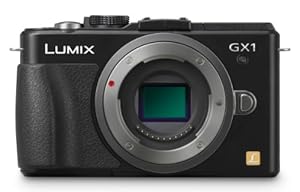Old Technology (?) - the Panasonic Lumix DMC-GX1
Image Source: http://www.amazon.com/gp/product/B00604YTFM/ref=oh_details_o00_s00_i00?ie=UTF8&psc=1
If you've followed my blog for very long, you'll know that I am a frequent user of Micro 4/3 equipment, specifically Panasonic Lumix cameras. My standard kit for the past year or so has been two DMC-G3 bodies, a great collection of mostly Lumix prime lenses (plus one Olympus lens, the spectacular 75mm f1.8), and a couple of zooms (Lumix 14-140mm and 100-300mm). I have enjoyed the convenience of having two identical camera bodies, small enough to carry together without any back pains, and allowing me to minimize lens swaps.
Well, I am in the process of making a change. While I have been watching new cameras come out, I haven't sprung for the latest and greatest. That's where the bottom-feeding comes in.
Bottom-feeding in camera gear usually means buying very inexpensive equipment, typically used. I'm doing my own type of bottom-feeding, taking advantage of the amazing price drops that come along for cameras that are, or are near to being, one generation back.
As you probably have read, I recently bought a Lumix DMC-LX7 compact camera brand new for less than $300. Amazing. This camera is so powerful it is the bargain of the year, in my opinion. In fact, it is so good I wrote an eBook about how I set it up for my uses.
(Click Here) or use the Amazon link below to get my LX-7 eBook.
Well, when I got the LX-7, I also bought the accessory live viewfinder, the Panasonic DMW-LVF2. This is where Micro 4/3 comes in. The LVF2 also fits the Lumix DMC-GX1, cousin to my G3s, with the same sensor, but in a more compact body, without an integral finder. The GX1 has a few features that the G3 does not, but it's the form factor that interests me most. It is very reminiscent of a rangefinder (though it's not), and extremely similar to the older DMC-GF1, a camera that I really enjoyed in its time. So, of course, I began looking at the GX1.
I know, if I'm going to upgrade, why not to the latest sensor technology, either the Lumix DMC-GH3, or maybe even an Olympus OM-D? Two reasons:
- The GX1, a camera that sold for $699 a year ago, is now available brand new on Amazon for $275! Can't touch an OM-D or GH3 for that price!
- Amazon will give me over $250 buy-back value for my G3!
Additionally, I don't like the large size of the GH3. Small size is why I got into Micro 4/3 in the first place.
Sure, I had to include my completely unused 14-42 mm kit lens to get the full buy-back value of the G3, and the new GX1 is body only. No problem.
So, for essentially no cost (even shipping for both cameras is free), I get to trade in a one year old (still in mint condition) G3 and kit lens for a brand new GX1 body. Since I already have the LVF2 finder, this is a no-brainer for me.
So, I'll let you know how this works out for me. Not having identical bodies may have some drawbacks. I think I will probably use the GX1 with my smaller lenses, like the 20mm f1.7 and 14mm f 2.5. I expect the small size of the GX1 to appeal to me, even though the LVF2 does take away from that characteristic.
I am not yet ready to invest in the latest sensor technology, even though I know the benefits are large. Maybe the GX2, if it ever gets announced (and especially if it also uses the same lvf2 finder) will change that.
DMC-365.blogspot.com

That's a good plan for the GX1. I've been enjoying my Lumix GF1 with 20mm/1.7 lens and an Olympus VF-1 optical viewfinder. The VF-1 gives a 4/3 image and the brightline (designed for a 17mm lens) is an excellent fit for the 20mm; and, the full VF image outside the brightline is a decent match for the Lumix 14mm lens. You might consider one of these. How does the LVF2 compare with the finder on the G3?
ReplyDeleteHi James,
ReplyDeleteThe LVF2 is great. I think it is roughly equivalent in quality to the built-in finder of the G3. I think the GX1 and LX7 with LVF2 will make a great pair.
Reed